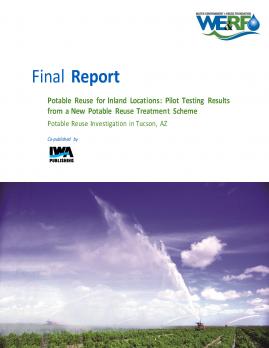 |
Potable Reuse for Inland Locations: Pilot Testing Results from a New Potable Reuse Treatment Scheme – Potable Reuse Investigation in Tucson, AZ
Potable Reuse for Inland Locations: Pilot Testing Results from a New Potable Reuse Treatment Scheme – Potable Reuse Investigation in Tucson, AZ

A dual-membrane treatment approach for potable reuse that includes microfiltration (MF), reverse osmosis (RO), and ultraviolet advanced oxidation (UVAOP) has been used at a number of full-scale facilities. Most of these facilities are located in coastal areas where the RO concentrate can be discharged with relative ease through existing ocean outfalls. Implementation of RO-based projects at inland locations can be challenging because of the environmental difficulty and high cost of disposing the waste stream generated by the RO process. The purpose of this research project was to evaluate, on a pilot scale, the feasibility of an alternative potable reuse treatment scheme that produces highly purified water without the need for RO and, therefore, in a more sustainable manner.
The treatment process evaluated in this research used a combination of processes, including short-term soil aquifer treatment (SAT), side-stream nanofiltration (NF), ozone oxidation, biological activated carbon (BAC) filtration, and granular activated carbon (GAC) adsorption. These processes provide multiple pathogen and organic barriers and achieve a significant degree of salinity reduction while producing less concentrate with significantly lower salinity than RO-based plants, creating more options for concentrate disposal. A simplified process flow diagram for the pilot-scale, potable reuse treatment scheme is shown in Figure ES.1. The process arrangement was designed to achieve the projects’ potable reuse treatment requirements (provide multiple barriers for removal of pathogens and organics and partial removal of total dissolved solids (TDS)) while minimizing project capital and operating costs. Successful demonstration of this alternative potable reuse scheme has the potential for application at a variety of inland locations that lack the less costly concentrate disposal method of ocean discharge.
A common treatment approach implemented at multiple potable reuse facilities around the world is microfiltration, reverse osmosis (RO) and advanced oxidation. Most of these facilities are located in coastal areas where the RO concentrate is discharged to the ocean. Implementing RO-based projects at inland locations is challenging because this is not an option. The purpose of this project was to evaluate the feasibility of an alternative non-RO-based potable reuse treatment scheme that produces highly purified water.
Project Number: Reuse-13-09
Publication Date: 15/09/2016eISBN: 9781780408491Pages: 241 |
Print:
|